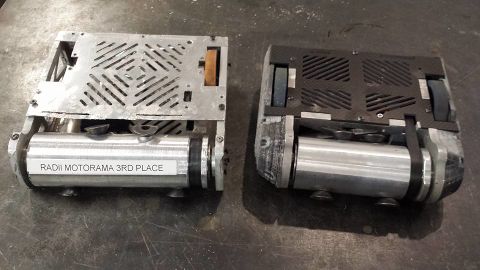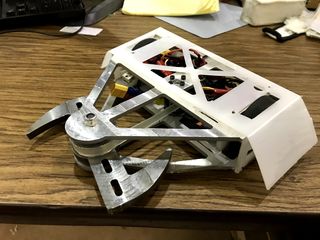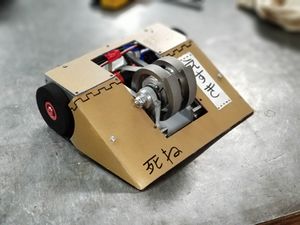Difference between revisions of "3lb Beginner's Guide"
(→Vertical Bar Spinner) |
(→Horizontal Bar Spinner) |
||
| Line 24: | Line 24: | ||
=== Horizontal Bar Spinner === | === Horizontal Bar Spinner === | ||
| − | [[File:chewi.jpg|thumb| | + | [[File:chewi.jpg|thumb|320x240px|Horizontal Bar Spinner]] |
'''Pros''' | '''Pros''' | ||
Revision as of 19:25, 5 July 2018
Contents
Introduction
- these
- are
- place holders
Choosing a Robot
Drum Spinner
Pros
- Great beginner bot
- Reliable due to simple weapon
- Outputs good damage
- Weapon doesn't require too much space away from the rest of the bot
- Easy to design so it can drive while flipped
Cons
- Smaller strike zone
- Gyroscopic effect can make fast turns hard
- Large heavy weapon
Horizontal Bar Spinner
Pros
- High Damage Output
- Large strike zone
- Easy to design so it can drive while flipped
Cons
- Robot must extend out to avoid its own weapon
- Gyroscopic effect make turning fairly difficult
- Needs a lot of structural support on the weapon to prevent damage from recoil
Vertical Bar Spinner
Pros
- Great damage output
- Allows for the use of a wedge, which acts to as armor and directs bots into the weapon
- If the weapon breaks, it still functions as a wedge bot
Cons
- Hard to allow for driving when flipped
- Gyroscopic effect can make driving difficult
- Weapon has to be smaller to maintain low center of gravity (keep the bot short)
Ring Spinner
Description of bot Pros
- pro 1
- pro 2
- pro 3
Cons
- con 1
- con 2
- con 3
Wedge
Description of bot Pros
- there are none
Cons
- con 1
- con 2
- con 3
What is a Robot
Here I imagine a table, containing typical parts (weapon, motors, receiver), descriptions of the parts, typical weights and dimensions, and accompanying picture(s)
Design Process
Introduction
Here's where there will be a small speech about the importance of the design process
Step 1: Sketch
Here's a description about how the sketching process works (limited dimensions, a focus of features, roundtable discussion)
Step 2: Draw
Here's a description about how the technical drawing process works (concentration of dimensions, viewpoints, and materials)
Step 3: Picking a motor
Here's a description on how to pick a motor (math n stuff)
Step 4: CAD Parts
Here's a description about how CADing the individual parts should work (the division of labor vs team all being on the same page)
Step 5: CAD Assembly
Here's a description about how assembling the CAD parts works (things to consider regarding final CAD for design review)
Step 6: Design Review
Here's a description about the design review (what to expect)
Step 7: Revise and repeat
Here's a description about what to do after the design review
Machining
Machines and what they do
- Machine 1: Does stuff
- Machine 2: Does other stuff
- Machine 3: Profit
Rules
- Rule 1: No killing yourself
- Rule 2: Beware the spinny bit on the mill
- Rule 3: No bathing in the water jet
Tips and Tricks
- How to turn on the waterjet
- Step 1:...
- Step 2:...
- What materials to use where
- If xyz breaks, do abc
Physics and Math (Oh my!)
Here's where there will be a rehashing of the math formulas and physics properties to know
Documentation
Here's where a guide regarding documentation will be
Previous bots
Here's where links to previous bots that are good examples will be
Probably another section I'm forgetting
meme


